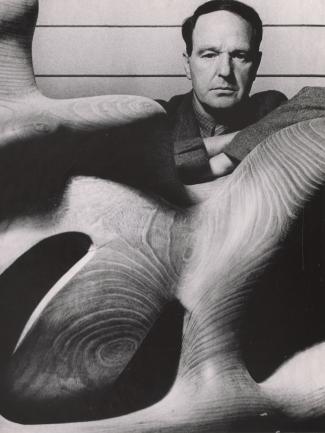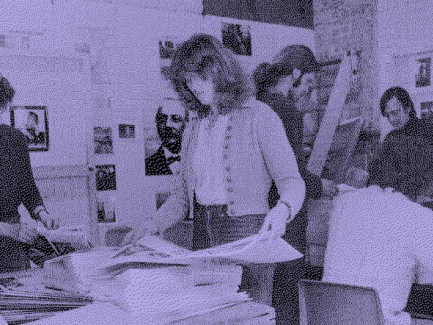Bill Brandt, Stonehenge under Snow (detail), 1947, printed later, gelatin silver print, Edwynn Houk Gallery, New York © Bill Brandt/Bill Brandt Archive Ltd.
Bill Brandt, Stonehenge under Snow (detail), 1947, printed later, gelatin silver print, Edwynn Houk Gallery, New York © Bill Brandt/Bill Brandt Archive Ltd.
Announcing “Bill Brandt | Henry Moore”
A fresh look at two masterful twentieth-century artists, tracing parallels and intersections in their photography and sculpture over three decades
NEW HAVEN, CT—Bill Brandt (1904–1983) and Henry Moore (1898–1986) first crossed paths during the Second World War, when both produced images of civilians sheltering in the London Underground during the Blitz; today, Brandt’s photographs and Moore’s shelter drawings rank among their most iconic works. On view at the Yale Center for British Art (YCBA) from November 17, 2022 through February 26, 2023, Bill Brandt | Henry Moore begins with these wartime works and traces the parallel and intersecting paths of the two artists over the postwar decades.
This major exhibition brings together nearly two hundred works, including drawings, photographic prints, sculptures, negatives, contact sheets, experimental collages, and rare color transparencies, alongside magazines and other media that published Brandt’s and Moore’s work. The display also features a selection of documentary films from prewar and wartime Britain, offering context for Brandt’s and Moore’s wartime works and illustrating the many ways that the British government deployed artists and images in service of the war effort.
Bill Brandt | Henry Moore opens with photographs and drawings that responded in real time to the destruction of war. Brandt and Moore brought out the uncanny, tomb-like conditions of underground tunnels and crypts that had been turned into makeshift shelters. Their dark, atmospheric images transformed the dismal ordeal of the blackout into elegiac and haunting compositions. Even before the end of the war, magazines and exhibitions showed Brandt’s photographs and Moore’s drawings side by side.
Brandt’s images of coal miners, housing estates, and unemployed workers and their families in Depression-era Britain obliquely reflect Moore’s personal history as one of eight children of a Yorkshire coal miner. Moore’s own coal mining drawings contributed to a visual culture in which coal was understood as vital to Britain’s war effort.
These dark and claustrophobic wartime subjects contrast with the light-filled, isolated landscapes and great megalithic sites of Britain to which Brandt and Moore were drawn throughout their careers. Amid the sweeping social, political, and economic changes of the 1940s and 1950s, the ancient geological forms of the British landscape served as powerful symbols of resilience, and both artists interpreted Stonehenge and Avebury as timeless emblems of national creativity and culture.
Later in their lives, Brandt and Moore came to focus on the subjectivity of nature and the human body. Found objects such as shells, pebbles, bones, and driftwood are explored as figurative sculptural forms—a shell could stand for a torso, a limb could become a pebble, and a foot could resemble a cliff.
Through the artists’ shared interest in themes of war, industry, family life, landscape, found objects, and the human body, the exhibition highlights the relationships between photography, sculpture, and other forms of image making. Brandt is revealed as a photographer who looked to sculpture as a means to reimagine his subjects, while Moore emerges as a sculptor and draftsman committed to photography as a creative medium.
Bill Brandt | Henry Moore was curated by Martina Droth, Deputy Director and Chief Curator at the Yale Center for British Art, and organized in partnership with The Hepworth Wakefield, UK. It was on view at The Hepworth Wakefield February 6 to November 1, 2020, and at the Sainsbury Centre, University of East Anglia, May 18 to August 22, 2021. The exhibition and its accompanying publication were generously supported by David Dechman and Michel Mercure, Laura and James Duncan (Yale BA 1975), the Andrew W. Mellon Foundation, and the John Pritzker Family Fund.
The exhibition is accompanied by a book of the same title, edited by Martina Droth and Paul Messier, Pritzker Director of the Lens Media Lab at the Yale Institute for the Preser-vation of Cultural Heritage. The publication features essays by leading scholars, including Carol Armstrong, Sebastiano Barassi, Eleanor Clayton, Lynda Nead, and John Tagg.
Related Programs
Opening Conversation
Bill Brandt | Henry Moore: Sculpture, Photography, and the Printed Page
Wednesday, November 16, 2022, 4 pm
Yale Center for British Art Lecture Hall and Livestream
Martina Droth, Deputy Director and Chief Curator, Yale Center for British Art, and Paul Messier, Pritzker Director of the Lens Media Lab at the Yale Institute for the Preservation of Cultural Heritage



